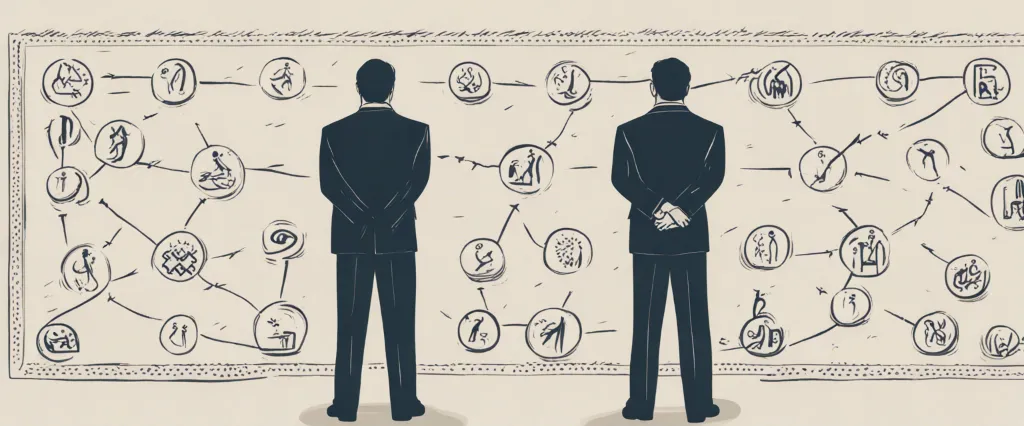——co-opetition by Adam M. Brandenburger & The E-myth Revisited by Michael E. Gerber

In the world of business literature, there is an abundance of books that aim to guide entrepreneurs and professionals toward success. Two such books, “Co-opetition” by Adam M. Brandenburger and “The E-Myth Revisited” by Michael E. Gerber, have gained considerable acclaim for their insightful perspectives on various aspects of entrepreneurship. While both books offer valuable insights, they approach the subject matter from different angles, presenting readers with distinct yet complementary approaches to achieving business excellence.
Co-opetition” delves into the concept of strategic thinking in a competitive environment. Written by Adam M. Brandenburger, a renowned professor and business strategist, this book challenges the traditional notions of competition by introducing the concept of co-opetition – the idea that collaboration, rather than solely competing, can lead to better outcomes for businesses. Through real-life examples and thorough analysis, Brandenburger explores how firms can benefit from both competition and cooperation simultaneously. By identifying and leveraging areas of mutual interests with competitors, organizations can create win-win scenarios and gain a sustainable competitive advantage.
Contrasting with the collaborative approach of “Co-opetition,” “The E-Myth Revisited” delves into the intricacies of entrepreneurship from a small business perspective. Authored by Michael E. Gerber, a highly influential business consultant, this book guides readers in understanding the systemic challenges faced by small business owners and provides practical solutions to overcome them. Gerber introduces the myth of the entrepreneur – the misconception that those skilled in a particular trade automatically possess the skills to run a successful business. Through engaging stories and actionable advice, Gerber emphasizes the importance of systematizing every aspect of a business to ensure longevity and growth. By adopting the mindset of an entrepreneur, rather than that of a technician, individuals can create scalable businesses that thrive independently of their daily involvement.
As the paths of these two books converge in the realm of entrepreneurship, a comparative study of “Co-opetition” and “The E-Myth Revisited” promises to shed light on the diverse strategies and perspectives necessary for navigating the complexities of the business world. Through an examination of their underlying principles, key insights, and practical implications, this study aims to explore their complementary nature and uncover valuable insights that can empower entrepreneurs and professionals alike. So, let us embark on a comparative journey, unraveling the secrets to business success woven within the pages of these compelling works.
Brief Summary of Two Books
co-opetition by Adam M. Brandenburger
“Co-Opetition: A Revolutionary Mindset that Combines Competition and Cooperation” by Adam M. Brandenburger and Barry J. Nalebuff introduces the concept of co-opetition, which challenges traditional notions of competition. The book argues that instead of focusing solely on beating competitors, businesses can benefit more by collaborating with them in certain areas.
The authors propose a framework that combines elements of competition and cooperation, emphasizing the idea that companies can create value through both rivalry and partnerships. They outline four strategies that effectively implement co-opetition: “coopetitive game,” “co-opetitive system,” “co-opetitive tactics,” and “co-opetition mindset.”
Brandenburger and Nalebuff provide numerous examples and case studies across different industries to illustrate how co-opetition can lead to mutual growth and success. They also emphasize the importance of properly assessing circumstances, identifying potential partners, and strategically positioning oneself within the market.
Ultimately, the book offers a strategic perspective on how businesses can navigate the complexities of the modern marketplace by combining competition and cooperation, fostering innovation, and creating value for all parties involved.
The E-myth Revisited by Michael E. Gerber
“The E-Myth Revisited” by Michael E. Gerber is a business book that explores the challenges faced by entrepreneurs and small business owners. Gerber argues that many entrepreneurs fail because they have the wrong mindset and approach to their business. According to him, the key to success lies in creating a well-organized and systematized business that can function independently of its owner.
Gerber introduces the concept of the “E-Myth,” which stands for the entrepreneurial myth. He explains that the E-Myth is the mistaken belief that entrepreneurs are primarily motivated by their technical skills or expertise in a certain field. However, he claims that success in running a business is not about technical expertise alone, but rather about developing three distinct roles: the entrepreneur, the manager, and the technician.
Gerber argues that many entrepreneurs focus too much on working in their business as technicians, doing the day-to-day technical work themselves, instead of working on their business as entrepreneurs. He emphasizes the importance of creating systems and processes that allow the business to run smoothly, even in the owner’s absence.
Throughout the book, Gerber introduces the concept of the “Franchise Prototype,” which is a systematic and replicable way of running a business. He advises entrepreneurs to think of their business as a franchise, regardless of its size, and outlines steps to create a comprehensive system that can be easily duplicated.
“The E-Myth Revisited” provides practical advice on how to structure and grow a successful business, from creating an organizational structure to hiring the right people and implementing effective training programs. Gerber stresses that having a clear vision, understanding the different roles in a business, and implementing systems are key to achieving long-term success.
Overall, the book serves as a guide for entrepreneurs, helping them understand the common pitfalls and providing a roadmap to transform their small business into a well-functioning, scalable enterprise.
Comparison between Two Books

Similarities in Business Strategy
Both “Parallel Co-opetition” by Adam M. Brandenburger and “The E-myth Revisited” by Michael E. Gerber discuss business strategy in different contexts, but there are some similarities between them.
1. Focus on Collaboration: Both books emphasize the importance of collaboration and partnerships for business success. “Parallel Co-opetition” promotes the idea of businesses forming cooperative relationships with their competitors to create new value and expand market opportunities. Similarly, “The E-myth Revisited” highlights the significance of building a team and delegating tasks effectively to achieve business growth.
2. Long-Term Vision: Both authors stress the need for a long-term vision and strategy in business. Brandenburger emphasizes the importance of creating sustainable competitive advantage through strategic cooperation, which requires a long-term commitment from all parties involved. Gerber advises entrepreneurs to develop a clear vision of their business’s future and align every aspect of their operations to that vision.
3. Focus on Systems and Processes: Both books recognize the importance of systems and processes in achieving business success. Brandenburger emphasizes that the success of cooperative strategies lies in designing effective systems for collaboration, while Gerber highlights the significance of developing standardized operating procedures within a business to ensure consistency and scalability.
4. Customer-Centric Approach: The authors in both books emphasize the need to focus on customer satisfaction and meeting customer needs. Brandenburger suggests that cooperative strategies should be designed to create more value for customers, while Gerber argues that businesses should focus on exceeding customer expectations through consistent delivery of products and services.
5. Adapting and Innovating: Both books highlight the importance of adaptability and innovation in business strategy. Brandenburger emphasizes the need for continuous learning and openness to change in order to maintain a competitive edge through cooperative strategies. Gerber advises businesses to constantly innovate and evolve to stay ahead of the competition and meet changing market demands.
While there are similarities, it’s important to note that these books approach business strategy from different angles. “Parallel Co-opetition” focuses on cooperative strategies with competitors, while “The E-myth Revisited” focuses on the importance of systems and processes in building a successful business. Nonetheless, the overlapping themes of collaboration, long-term vision, systems/processes, customer-centricity, and adaptability highlight common principles in business strategy.
Divergences in Business Strategy
Co-opetition by Adam M. Brandenburger and The E-Myth Revisited by Michael E. Gerber are both highly regarded books in the field of business strategy, but they approach the subject from different perspectives. While there are similarities in terms of providing insights into building and managing successful business enterprises, there are notable divergences in their approach to strategy.
1. Emphasis on Competition vs. Collaboration: Co-opetition primarily focuses on the concept of fostering collaboration and strategic alliances between traditionally competitive firms. Brandenburger argues that businesses can benefit by aligning their interests and combining resources to create competitive advantages. On the other hand, The E-Myth Revisited emphasizes the role of entrepreneurship and individual businesses, focusing on achieving success through efficient and scalable systems and processes. It pays less emphasis on collaboration and more on building a highly efficient and self-sustaining organization.
2. External vs. Internal Factors: Co-opetition takes into account the external environment and how businesses should strategically position themselves in relation to competition, customers, and suppliers. It delves into the dynamic nature of markets and the importance of understanding and leveraging interdependencies. On the contrary, The E-Myth Revisited places greater emphasis on internal factors, such as establishing clear roles and responsibilities, developing efficient processes, and ensuring consistent delivery of products or services. It focuses on creating a solid foundation within the organization first before venturing into strategic alliances or partnerships.
3. Strategic Thinking vs. Operational Efficiency: Co-opetition promotes strategic thinking and the ability to analyze complex situations, identify opportunities for cooperation, and effectively allocate resources. It encourages businesses to think strategically about how to create value and gain competitive advantage in a win-win manner. The E-Myth Revisited, however, emphasizes operational efficiency and the importance of implementing systems and procedures that relieve business owners from being trapped in their daily operations. It aims to create a business that functions smoothly and efficiently, with employees fulfilling their roles effectively.
4. Different Target Audience: While both books are valuable for entrepreneurs and business professionals, they cater to different stages of a business’s development. Co-opetition is more suitable for established businesses that have already achieved a certain level of market presence and are looking for ways to enhance their competitive advantage. The E-Myth Revisited, on the other hand, targets entrepreneurs and small business owners who are in the early stages of building their businesses and need guidance on establishing a solid foundation for growth.
In conclusion, Co-opetition and The E-Myth Revisited provide valuable insights into business strategy, but they approach the topic from different angles. Co-opetition focuses on fostering collaboration and strategic alliances, while The E-Myth Revisited emphasizes operational efficiency and developing systems for establishing a successful business. Understanding these divergences helps readers choose the book that aligns best with their specific business goals and needs.

Conclusion
Both “Co-Opetition” by Adam M. Brandenburger and “The E-Myth Revisited” by Michael E. Gerber offer valuable insights in their respective areas of focus. The decision of which book to read depends on your specific interests and needs.
If you are interested in understanding how to navigate business competition and create successful collaborations, “Co-Opetition” is a highly recommended choice. It explores the concept of “co-opetition,” which emphasizes finding opportunities for cooperation with competitors to achieve mutual benefits while still maintaining healthy competition. This book provides a unique perspective on strategic thinking and can be particularly valuable for those in business or entrepreneurship.
On the other hand, if you are looking for guidance on how to build and improve your own business, “The E-Myth Revisited” is an excellent pick. This book focuses on debunking the myths and misconceptions of becoming an entrepreneur and delves into the operational aspects of running a successful business. It offers practical advice and outlines a systematic approach to developing and scaling a business, making it especially useful for small business owners and aspiring entrepreneurs.
Ultimately, both books provide distinct perspectives that can enhance your knowledge and understanding in different areas of business. Consider your goals and interests in order to choose the book that aligns more closely with what you are seeking to learn and apply in your own professional journey.


